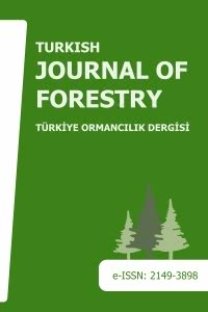Çankırı yöresi sarıçam meşcereleri için dinamik bonitet endeks modellerinin otoregresif modelleme ile geliştirilmesi
Developing dynamic site index models by using autoregresive modeling approach for scots pine stands in Çankırı forests
___
- Adame, P., Cañellas, I., Roig, S., Del Rio, M., 2006. Modeling dominant height growth and site index curves for Rebollo oak (Quercus pyrenaica Willd.). Ann. For. Sci. 63:929-940.
- Álvarez-González, J., Ruiz Gonzalez, A., Rodriguez Soalleiro, R., Barrio Anta, M., 2005. Development of ecoregion-based site index models for even-aged stands of Pinus pinaster Ait. in Galicia (northwestern Spain). Ann. For. Sci., 62:117-129.
- Akalp, T., 1978. Anomorfik ve polimorfik yöntemlerle bulunmuş bonitet eğrilerinin karşılaştırılması. İ.Ü. Orman Fakültesi Dergisi, 28:213-232.
- Bailey, R.L., Clutter, J.L., 1974. Base-Age invariant polymorphic site curves. Forest Science, 20:155-159.
- Bravo-Oviedo, A., del Río, M., Montero, G., 2007. Geographic variation and parameter assessment in generalized algebraic difference site index modeling. Forest Ecology and Management, 247(1-3):107-119.
- Benito, D.M., Izquierdo, G.G., Rio, M.D. Cañellas, I., 2008. Long-term trends in dominant-height growth of black pine using dynamic models. Forest Ecology and Management, 256:1230-1238.
- Carmean W.H., 1972. Site index curves for upland oaks in the central states. Forest Science, 18:109-120.
- Cieszewski, C.J., 1999. The Algebraic Difference Approach Improves Fixed Base-Age Site Models Based On Chapman-Richard Function, PMRC Technical Report 1999-9.
- Cieszewski, C.J., 2001. Three methods of deriving advanced dynamic site equations demonstrated on inland douglas- fir site curves. Canadian Journal of Forest Research, 31:165-173.
- Cieszewski, C.J., 2002. Comparing fixed and variable-base- age site equations having single versus multiple asymptotes. Forest Science, 48(1):7-23.
- Cieszewski, C.J., 2003. Developing a well-behaved dynamic site equation using a modified hossfeld IV function Y3 = (Axm)/ (C + Xm-1), a simplified mixed-model and scant subalpine fir data. Forest Science, 49:539-554.
- Cieszewski, C.J., 2004. GADA Derivation of Dynamic Site Equations with Polymorphism and Variable Asymptotes From Richards to Weibull and Other Exponential Function., Plantation Management Research Cooperative, 10 s., Athens.
- Cieszewski, C.J., Bailey, R.L., 2000. Generalized algebraic difference approach: theory based derivation of dynamic site equations with polymorphism and variable asymptotes, Forest Science, 46:116-126.
- Cieszewski, C.J., Nigh, G., 2002. A dynamic equation for a Sitka Spruce height-age model. Forest Chronicle 78(5): 1-5.
- Cieszewski, C.J., Strub, M., 2008. Generalized algebraic difference approach derivation of dynamic site equations with polymorphism and variable asymptotes from exponential and logarithmic functions. Forest Science, 54:303-315.
- Cieszewski, C.J., Strub, M., Zasada, M.J., 2007. New dynamic site equation that fits best the schwappach for scots pine (Pinus Slyvestris L.) in central Europe. Forest Ecology and Management, 23:83-93.
- Clutter J.L., Fortson, J.C., Peinar, L.V., Brister, G.H., Bailey, R.L., 1983. Timber Management A Quantitative Approach, Wiley, 333 s., New York.
- Diéguez-Aranda, U., Burkhart, H.E., Rodriguez-Soalleiro, R., 2005. Modeling dominant height growth of radiata pine (Pinus radiata D. Don) plantations in north-western Spain. Forest Ecology and Management, 215:271-284.
- Diéguez-Aranda, U., Grandas-Arias, J.A., Álvarez- González, J.G. Gadow, K.V., 2006. Site quality curves for birch stands north-western spain. Silva Fennica, 40(4):631-644.
- Doğanay, B., 2007. Uzunlamasına çalışmaların analizinde karma etki modelleri. A.Ü. Sağlık Bilimleri Enstitüsü Yüksek Lisans Tezi, 94 s. Ankara.
- Eraslan, İ., 1982. Orman Amenajmanı. İstanbul Üniversitesi Orman Fakültesi, Yayın No:318.
- Ercanlı, İ., 2010. Trabzon ve Giresun orman bölge müdürlükleri sınırları içerisinde yer alan Doğu Ladini (Picea orientalis (L.) Link)-Sarıçam (Pinus sylvestris L.) karışık meşcerelerine ilişkin büyüme modelleri. Doktora Tezi, K.T.Ü. Fen Bilimleri Enstitüsü, Trabzon.
- Fox, J., 1997. Applied Regression Analysis, Linear Models, and Related Methods. Thousand Oaks, CA: Sage. Garcia, O., 1981. Simplified Method of Moments Estimation for The Weibull Distribution. New Zelland Journal of Forest Science, 11(3):304-306.
- Gregoire, T., Schabenberger, O., Barret, J., 1995. Linear modelling of irregularly spaced, unbalanced, longitudinal data from permanent-plot measurements. Can. J. For. Res., 25:137-156.
- Günel, A., 1982. Orman Hasılat Bilgisi Ders Notları. İ.Ü. Orman Fakültesi (Basılmamıştır), 89 s.
- İyit, N., 2008. İlişkili veri analizinde lineer karma modellerin yapılandırılması. S.Ü. Fen Bilimleri Enstitüsü Doktora Tezi, 162 s., Konya.
- İyit, N., Genç, A., Arslan, F., 2006. Analysis of repeated measures for continuoes response data using general linear model and mixed models. Proceedings of The İnternational Conference on Modeling And Simulation, 937-942, Konya.
- Kalıpsız, A., 1998. Orman Hasılat Bilgisi. İ.Ü. Orman Fakültesi Yayınları, No:4060/448, 349 s., İstanbul.
- Monserud, R.A., 1984. Height growth and site index curves for inland douglas-fir based on stem analysis data and forest habitat type. Forest Science, 30:943-965.
- Nord-Larsen, T., 2006. Developing dynamic site index curves for European beech (Fagus sylvatica L.) in Denmark. Forest Sci., 52:173-181.
- Parresol B.R., Vissage J.S., 1998. White Pine Site Index for The Southern Forest Survey, USDA For. Serv. Res. Pap. SRS-10.
- SAS Institute Inc. 2004. SAS/ETS® 9.1 User’s Guide. Cary, NC: SAS Institute Inc.
- Searle, S.R., Casella, G., McCulloch, C.E., 1992. Variance Components. John Wiley and Sons Inc. USA.
- Spur, S.H., 1952. Forest Inventory. Ronald Press, 476 s., New York.
- Trincado, G.V., Kiviste, A., Gadow, K.V. 2003. Preliminary site index models for native Roble (Nothofagus obliqua) and Rauli (N.alpina) in Chile. New Zeland. J.For.Res- JPN 32(3):322-333.
- Ye, S., 2005. Covariance structure selection in linear mixed models for longitudinal data. M.Sc. Thesis, Department of Bioinformatics and Biostatistics, University of Lousville, Kentucky, 230 p., USA.
- ISSN: 1302-7085
- Yayın Aralığı: Yılda 2 Sayı
- Başlangıç: 2000
MUSTAFA YILMAZ, FATİH TONGUÇ, Tolga OK
Çimentolu yonga levhanın bazı özelliklerine rutubet değişimin etkisinin belirlenmesi
FATİH YAPICI, HÜSEYİN YÖRÜR, İLKER YALÇIN
Serbest ormancılık büroları ve orman mühendisi istihdamına etkisi
Atakan Öztürk, Ümit AKTAN, UFUK DEMİRCİ
Antalya yöresi doğal kızılçam meşcereleri için genelleştirilmiş çap-boy modellerinin geliştirilmesi
Bitki kökleriyle şev stabilizasyonun sonlu elemanlar yöntemiyle incelenmesi
Ali Kemal ARKUN, MUSTAFA ERGEN, FERİT ÇAKIR
MDF atıklarının odun plastik kompozitlerin üretiminde değerlendirilmesi
Nilgül ÖZMEN, NİHAT SAMİ ÇETİN, NASIR NARLIOĞLU, VEDAT ÇAVUŞ, ERTUĞRUL ALTUNTAŞ
Ormanların heyelan oluşumu üzerindeki etkileri
Isıl işlem uygulanmış bazı ağaç malzemelerde yapışma direncinin belirlenmesi
İLKER ERCANLI, Muammer ŞENYURT, Ferhat BOLAT
Sürdürülebilir orman yönetimi ölçüt ve göstergelerinin Türkiye için modellenmesi
